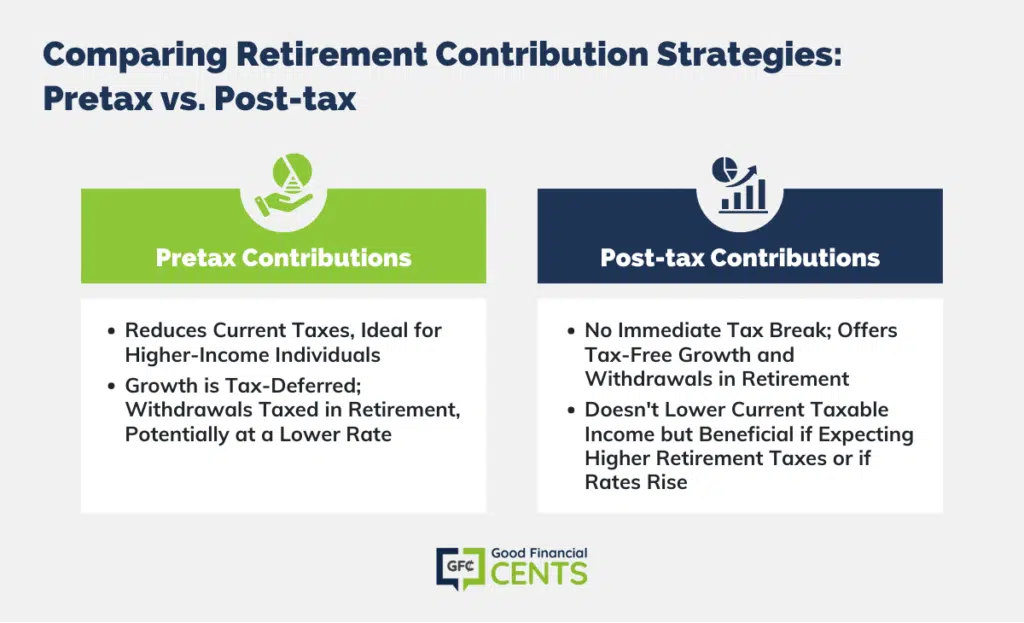Given how common job changes are, and the need to rollover retirement savings after the fact, this is an important question.
Retirement plans are now complicated on two fronts – making pre- and post-tax contributions, then splitting them after the fact between traditional and Roth IRAs to take advantage of that tax configuration.
We received an Ask GFC question on this very topic from a reader who did not supply his name:
“We want to roll over my wife’s IRA at her prior job to a new IRA but spilt it
into traditional IRA for the pretax amount and a roth IRA for the post tax amount. Can this be done?”
I suspect that what the reader was referring to when he said “my wife’s IRA at her prior job”, he really meant her 401(k), or some other employer-sponsored retirement plan. That’s the assumption I’ll make, since an IRA is a self-directed account, and not sponsored by an employer. I’ll also assume that the part about “split it into a traditional IRA, etc.” does actually refer to an IRA since that’s the usual destination for employer retirement plans after a job ends.
Getting to the reader’s question, can this be done? the short answer is yes! Let’s go over the details and other considerations that may apply.
Table of Contents
- What Are Pretax and Post-tax Contributions?
- How Do You End Up Making Non-Deductible 401(k) Contributions?
- Pretax and Post-Tax 401(k) Contributions Are Usually Separated
- Both Pre-Tax and Post-Tax 401(k)’s Must Be Rolled Over at Once
- Treatment of the Deferred Income Portion of the Post-Tax Distribution
- Bottom Line: Splitting Rollovers Between Pretax and Post-tax
What Are Pretax and Post-tax Contributions?
Pretax Contributions
Contributing to a retirement account on a pre-tax basis has various advantages. First, it reduces your current taxable income, allowing you to pay less in taxes today. This upfront tax break can be particularly beneficial for individuals in higher tax brackets. Additionally, pretax contributions grow tax-deferred, meaning the investment earnings are not taxed until withdrawn in retirement.
Pretax contributions will be taxed as ordinary income upon withdrawal in retirement. This includes both the initial investment and any earnings. The tax rate will depend on your income bracket in retirement, which could be lower than your current tax rate, further maximizing the benefits of pre-tax contributions.
Post-tax Contributions
Post-tax contributions, while not providing an immediate tax break, come with their own set of benefits. The most significant advantage is that post-tax dollars grow tax-free, and qualified withdrawals are not taxed. This means both your contributions and any earnings can be withdrawn tax-free in retirement, provided certain conditions are met.
Since contributions are made with after-tax dollars, they do not reduce your current taxable income. However, they do allow for tax-free growth and withdrawals, assuming the withdrawals are qualified. This can be particularly advantageous if you expect to be in a higher tax bracket in retirement or if tax rates increase.

How Do You End Up Making Non-Deductible 401(k) Contributions?
Most people are probably more familiar with making non-deductible IRA contributions. That’s when you are covered by an employer-sponsored retirement plan, your income exceeds the limit to make a deductible contribution, and you make a contribution anyway. You can’t deduct the contribution from your income taxes, but the money in the account grows on a tax-deferred basis, so it’s generally worth doing.
The same thing can happen with a 401(k) plan. Under IRS regulations, you can make contributions of up to $7,000 ($8,000 if you’re age 50 or older). But since the actual maximum contribution to a 401k retirement plan is $69,000 ($76,500 if age 50 or older), some employers will allow you to contribute more than the standard 401(k) limits, but the contributions will not be tax-deductible.
Not all employers participate in this arrangement, but more are starting to allow it. When they do, they must typically segregate the accounts, between pretax and post-tax, at least upon distribution. This separate handling of the two types of contributions is actually quite recent, so don’t be too upset if you are not familiar with it. In fact, the change was implemented through new regulations that became effective on September 18, 2014.
The segregation of the two types of accounts provides greater flexibility as to what you can do with accounts when they are rolled over, particularly in regard to the Roth IRA.
Pretax and Post-Tax 401(k) Contributions Are Usually Separated
If you have made both pretax and post-tax 401(k) contributions – or even to other types of employer-sponsored retirement plans – the distributions from the plan will typically be separated. The distribution will show a pro-rata share of both pre-tax and post-tax contributions to your plan.
For example, if you have $200,000 being distributed from the 401(k) plan of your previous employer, and includes $150,000 in pretax amounts and $50,000 in post-tax amounts, the distribution split will be 75%/25% pretax/post-tax.
This makes rolling over the distributions neat and convenient. If you receive a $100,000 distribution from the plan, you can move $75,000 into a traditional IRA, and pay no income tax on the rollover. The remaining $25,000 can be rolled over into a Roth IRA.
The portion of the post-tax portion of the 401(k) that is attributed to contributions to the plan can be rolled over to the Roth IRA free of income taxes since taxes on the income were already paid. But even the portion that represents tax-deferred investment income on those contributions, which would ordinarily be subject to ordinary income, tax gets special consideration, which we will cover in the final section.
You can also request that a portion of the post-tax contributions be sent to you directly, and there will be no tax on the contribution portion since no tax deduction was taken when the contribution was made.
Both Pre-Tax and Post-Tax 401(k)’s Must Be Rolled Over at Once
One of the limitations of this method of distribution is that you cannot cherry-pick how it will be done. Using the example above, of a $200,000 401(k) plan in which $50,000 represents the post-tax portion, you cannot withdraw $50,000 from the plan and claim that it is all post-tax contributions.
It will instead be distributed using the same pro rata formula. In this case, 75% of the distribution, or $37,500, will be distributed as pre-tax contributions. Only 25%, or $12,500, will be considered to be post-tax contributions. The pro rata allotment always dictates how the distributions will be classified.
No matter how much money is distributed from your previous employer’s 401(k) plan, the split will always be 75%/25%. This will be true whether the distribution is rolled over into another employer-sponsored retirement plan, or a split between a traditional IRA and a Roth IRA.
Treatment of the Deferred Income Portion of the Post-Tax Distribution
When you make contributions to a 401(k) plan, whether they are made on a pre-tax or post-tax basis, investment income will accumulate on those contributions on a tax-deferred basis. In theory, at least, this could make at least some part of the post-tax portion of your 401(k) distribution taxable, even if you roll it over into a Roth IRA.
But part of the change that occurred in the 2014 new regulations is that you are now able to also separate the actual contributions from the post-tax portion of your 401(k) plan, from the investment earnings that they produced.
That means that you will be able to roll over the actual post-tax contributions made to the post-tax portion of your 401(k) plan into a Roth IRA, free of income taxes on the rollover. The investment income earned on those contributions can then be rolled over into a traditional IRA, which will enable you to continue to defer income taxes on those earnings.
In this way, 100% of your 401(k) plan distribution – including pre-tax and post-tax contributions, and the investment earnings on both sets of contributions – can be rolled over to a mix of traditional and Roth IRAs, and you will pay no income tax on the rollover.
From that point forward, the portion that has been rolled over into the Roth IRA will continue to generate tax-deferred investment income. But since it is a Roth IRA, it can be withdrawn tax-free, after you turn 59 1/2 and as long as you have been in the Roth IRA for at least five years.
Meanwhile, the portion rolled over into a traditional IRA will continue to produce tax-deferred investment income. That income will not be taxed until you begin taking distributions from the IRA when you retire. As long as you are at least 59 1/2 when you begin taking distributions, they’ll be subject only to ordinary income tax (at whatever your income tax rate is at the time) and no early withdrawal penalties will apply.
This is a pretty generous arrangement from a tax standpoint and makes a strong case for making both pretax and post-tax 401(k) contributions if your employer allows you to do that.
Bottom Line: Splitting Rollovers Between Pretax and Post-tax
Employer-sponsored retirement plans, like 401(k)s, can accommodate both pre-tax and post-tax contributions. Thanks to regulations effective from 2014, these contributions are typically segregated, allowing for strategic rollovers. When leaving a job, one can conveniently roll over pre-tax amounts to a traditional IRA and post-tax amounts to a Roth IRA, optimizing tax benefits.
Additionally, investment earnings from post-tax contributions can be directed to a traditional IRA, ensuring continued tax deferral. This flexibility enhances the value of making diverse 401(k) contributions.








From the SEC:
Roth 401(K) Plans – An employer-sponsored Roth 401(k) plan is similar to a traditional plan with one major exception. Contributions by employees are not tax-deferred but are made with after-tax dollars. Income earned on the account, from interest, dividends, or capital gains, is tax-free.